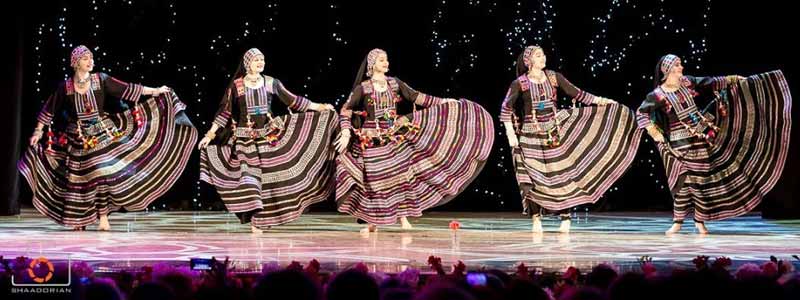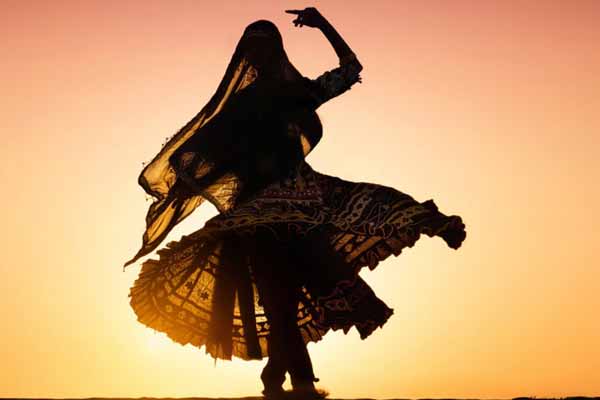Best Folk Dances in Rajasthan The cultural capital of India, Rajasthan, is a state located in the north-western part of the Indian subcontinent. Jaipur, located in the east-central part of the state, is its capital. The name Rajasthan means “The Abode of the Rajas”; it was formerly called Rajputana, “The Country of the Rajputs”.
Ghoomar is a traditional folk dance of Rajasthan, performed by the women folk who are clad in veils and flowing dresses called “ghaghra”. It was ranked 4th in the list of “Top 10 local dances around the world” in 2013. The word ghoomna describes the twirling movement of the dancers and is the basis of the word ghoomar.
Chari dance is prominent amonst Gujjar and Saini community of Kishangarh and Ajmer in Rajasthan. Chari dance is a female group dance and is performed at marriage celebrations, on the birth of a male child and during festivals. Dancers carry flaming pots on their heads, without giving any support with their hands, while performing graceful movements with their limbs and hips.
Chakri Dance is performed in almost all the marriages and festivals in the Haroti region of Rajasthan. Chakri translates to “Chakkar” in Hindi and Circle in English, and the highlight of the dance is the circular motion of the dancers sitting on their knees, twirling round and round in circles, with their skirts in constant flare to the rhythmic beats of the “Nagara”.
The popular folk song, “Pallo Lat Ke”, depicts the emotional disputes between the bride and the bridegroom, during the occasion of their wedding, Best Folk Dances in Rajasthan.
Kalbelia or Kabeliya is one of the most famous dance forms of Rajasthan, performed by a tribe of the same name. The Kalbeliya tribes are nomads and are traditional serpent charmers. Hence, the dance movements and the costumes bear a resemblance to that of the serpents. Both men and women participate in the dance.
Holiya Me Ude Re Gulal… is a Rajasthani folk dance that exalts the celebration of the Indian festival of colours, Holi.
Tarazu symbolises the equilibrium that the people of Rajasthan maintain in all aspects of their life. Be it the sun baked sands of the desert or the coolness inside the mud huts, the people of Rajasthan does a balancing act, which strikes a harmonious blend with Mother Nature Rajasthan Budget Tours.

Kalbeliya
Since the year 2010, the Kalbelia Folk Dance has been included in the list of Cultural Heritage of Humanity by UNESCO. This folk dance of Rajasthan which is also popularly known as the snake charmer dance or sapera dance is performed by women belonging to the Kalbelia community. The dance steps in this folk dance represent the movements of a serpent, hence the name. Performed during festivals such as Holi, the women dance to Kalbelia songs that focus on folklore and mythology.
The Kalbelia women wear a traditional costume which consists of an angrakhi which is a jacket, odhani which is a veil, and long black and red swirling ghagharas having beautiful embroidered patterns in different colors. The dance is accompanied by traditional instruments such as the poongi, dufli, dholak, khuralio, khanjari, and morchang. The Kalbelia folk dance is quite popular in Ajmer, Chittorgarh, Pali district, and Udaipur district Best Folk Dances in Rajasthan.
Kathputli
The famous puppet dance of Rajasthan was bound to be on this list. The Bhat community of Rajasthan started performing this art form some 1000 years ago and it still hasn’t lost its charm. Kathputli comes from kath meaning wood and putli meaning doll. The puppeteers not only control these puppets with strings but also sing tales of Indian mythology and various folk tales. This is one folk dance of Rajasthan which is not just popular among adults but also among children Best Folk Dances in Rajasthan.
Kathputli refers to puppets, and hence, it is also often referred to as the puppet dance. These puppets are made of mango wood, filled with cotton, and colorfully dressed. Having a height of about one and half feet, they are usually made in Udaipur, Bari, and Sawai-Madhopur. The Kathputli folk dance is not used just for entertainment purposes but also for spreading social messages and portraying various mythological, historical, and folklore stories. The puppets are controlled using strings attached to them and the puppeteers are also the ones who sing the son on which they make these puppets dance. The Kathputli folk dance truly brings out the essence of Rajasthan and its culture and traditions.
Ghoomar
The Ghoomar folk dance is one of the most popular folk dances of Rajasthan and it is popular not just in India but throughout the world as well. This dance form originated in the Bhil community but was later on adopted by other communities as well, including the Rajput women. Though this folk dance has very simple steps, its beauty lies in the graceful movements which include swaying of hands, clapping, twirling around, etc. Ghoomar is performed only by women who wear colorful lehenga cholis and cover their faces with an odhani (veil) while dancing to traditional songs accompanied by traditional instruments.
The main USP of this folk dance of Rajasthan is the way women twirl around in perfection which not just shows off their talent and skill but also the mesmerizing colors of their ghaghras. It is often performed during Rajput weddings, Holi, Teej, etc. You can catch a performance of Ghoomar folk dance in Jodhpur, Udaipur, Bundi, and Kota.
Bhavai
The Bhavai folk dance is considered as one of the most difficult folk dances of Rajasthan and it can take several years for the dancers to master it completely. This dance form is mainly performed by women belonging to tribal communities such as Bhil, Kumhar, Meen, Jat, and Kalbelia. In this folk dance of Rajasthan, women balance around 8-9 brass or earthen pots on their head and twirl around while standing on the edge of a plate, glass, or even a naked sword Best Folk Dances in Rajasthan.
This dance form is nothing less than a miraculous stunt by the skilled women dancers. While the women dance, the male performers usually sing and play instruments such as sarangi, dholak, harmonium, etc. You will find this folk dance traditionally performed at weddings and it is quite popular in Udaipur, Chittorgarh, Dungarpur, and Banswara.
Gair
Performed during the festival of Holi, the Gair folk dance is a beautiful synchronized art form performed by both men and women who hold sticks in their hands as props. In this group dance, the performers make two circles and dance around performing various steps in clockwise and anti-clockwise directions. Along with swinging their arms to the beats of the drums, the men also hit their sticks, thus, producing a delightful rhythm. The women performers are decked in colorful ghagra choli and the men are decked in a full-length traditional kurta and carry a sword, stick, and arrow.
This dance is usually performed in the Mewar region of Rajasthan by the women and menfolk of the Bhil tribe. There are different variations of this dance performed in Marwar region known as Dandi Gair and in the Sehkhawati region known as Geendad dance.
Kachchhi Ghodi
The men of the Shekhawati region of Rajasthan perform this highly entertaining folk dance. A dummy horse made out of bamboo and paper is tied around the waist of these dancers. They dance around and have mock fights that depict folk tales about the local bandits. The tune of a flute and a dhol is usually used during this performance. It is basically performed as a form of entertainment at social gatherings such as weddings.
Chang/Dhamal
Chang is actually the name of the instrument that is used to create music for this dance form, hence the name. This fascinating dance form sometimes involves men dressed as women as they perform a highly upbeat performance that is exciting to watch. It is usually performed from the start of Maha Shivaratri to the festival of Holi. It is one of the best folk dances of Rajasthan that is specific to the Shekhawati region that is in the towns of Bikaner, Churu, Sikar, and Jhunjhunu.
Terah Taali
This form of dance is quite interesting as it involves 13 brass discs tied to different body parts of the dancers. Their movements allow the discs to collide with each other and the sound produced is the rhythm that helps them dance. The dancers may also hold swords in their mouths and balance pots on their heads which makes this dance even more engaging to watch. This is mainly performed by the Kamada tribe of Rajasthan, while some other tribes such as Mirasi and Bhat may also perform. The Pokhran and Deedwana perform this folk dance in order to honor Baba Ramadeo, their folk hero.
